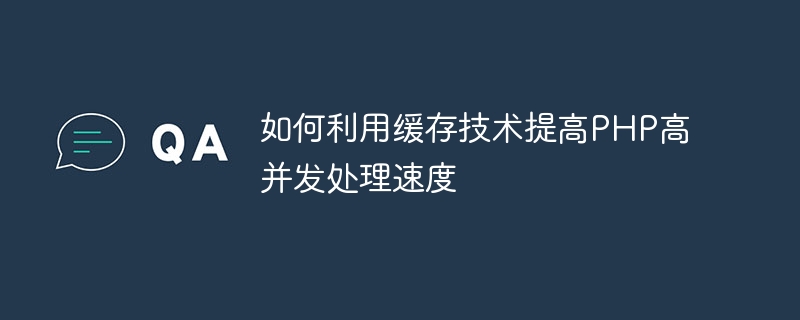Home >Backend Development >PHP Tutorial >How to use caching technology to improve PHP high concurrent processing speed
How to use caching technology to improve PHP high concurrent processing speed
- WBOYWBOYWBOYWBOYWBOYWBOYWBOYWBOYWBOYWBOYWBOYWBOYWBOriginal
- 2023-08-10 12:55:441373browse

How to use caching technology to improve the high concurrent processing speed of PHP
With the popularity of the Internet and the development of websites, PHP, as a commonly used website development language, has The need for concurrent processing is also increasing. In high-concurrency scenarios, in order to improve the response speed and performance of the website, using caching technology is a common method. This article will introduce how to use caching technology to improve PHP's high-concurrency processing speed, and give corresponding code examples.
- What is caching technology?
Caching technology refers to storing calculation results or data in high-speed storage media so that they can be quickly obtained during the next access. In web development, commonly used caching technologies include page caching, database caching, object caching, etc. Using caching technology can reduce the number of database accesses and improve the response speed and overall performance of the website. - Page caching
Page caching is to store the complete page content in the cache, and directly return the cached page content the next time you access it, without the need to execute PHP scripts and database queries. In high-concurrency scenarios, page caching can greatly reduce the load on the server and improve response speed.
The following is a simple sample code for page caching:
<?php
// 检查缓存文件是否存在
if (file_exists('cache/pagecache.html') && time() - filemtime('cache/pagecache.html') < 300) {
// 如果缓存文件存在且未过期,直接输出缓存内容
echo file_get_contents('cache/pagecache.html');
} else {
// 如果缓存文件不存在或已过期,执行页面渲染逻辑
ob_start();
// ... 页面渲染逻辑 ...
$content = ob_get_clean();
// 将页面内容写入缓存文件
file_put_contents('cache/pagecache.html', $content);
echo $content;
}
?>In the above code, check whether the cache file exists and has not expired. If the cache file exists and has not expired, the cache content is output directly, otherwise the page rendering logic is executed and the page content is written to the cache file.
- Database cache
Database cache stores database query results in the cache. The next time the same data is queried, the cached query results are directly returned without querying the database again. In high-concurrency scenarios, database caching can reduce the number of database accesses and improve the response speed of the website.
The following is a sample code for a simple database query cache:
<?php
function getArticles() {
// 检查缓存
$cacheKey = 'cache:articles';
$articles = cache_get($cacheKey);
// 如果缓存存在,直接返回缓存数据
if ($articles) {
return $articles;
}
// 如果缓存不存在,查询数据库
$sql = "SELECT * FROM articles";
$result = mysqli_query($connection, $sql);
$articles = mysqli_fetch_all($result, MYSQLI_ASSOC);
// 将查询结果存储到缓存中
cache_set($cacheKey, $articles, 300);
return $articles;
}
// 调用函数获取文章列表
$articles = getArticles();
?>In the above code, first check whether the cache exists. If the cache exists, the cached data is returned directly; otherwise, the database query is executed and the query results are stored in the cache.
- Object caching
Object caching is to store objects in the cache and directly return the cached object the next time it is accessed without re-creating the object. In high-concurrency scenarios, object caching can reduce the number of object creations and improve the response speed of the website.
The following is a sample code for a simple object cache:
<?php
class User {
// ... 用户属性和方法 ...
public static function getById($id) {
// 检查缓存
$cacheKey = 'cache:user:' . $id;
$user = cache_get($cacheKey);
// 如果缓存存在,直接返回缓存对象
if ($user) {
return $user;
}
// 如果缓存不存在,查询数据库
$sql = "SELECT * FROM users WHERE id = $id";
$result = mysqli_query($connection, $sql);
$userData = mysqli_fetch_assoc($result);
// 创建User对象
$user = new User($userData);
// 将User对象存储到缓存中
cache_set($cacheKey, $user, 300);
return $user;
}
}
// 调用静态方法获取用户对象
$user = User::getById(1);
?>In the above code, first check whether the cache exists. If the cache exists, return the cache object directly; otherwise, perform a database query and create a User object, and then store the User object in the cache.
Summary:
Using caching technology can effectively improve the speed of PHP high-concurrency processing. Page caching, database caching, and object caching are all common caching technologies. By implementing corresponding caching logic, the number of database accesses, page renderings and object creations can be reduced, and the response speed and overall performance of the website can be improved.
The above is the detailed content of How to use caching technology to improve PHP high concurrent processing speed. For more information, please follow other related articles on the PHP Chinese website!

